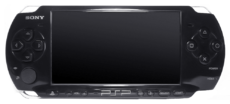The PlayStation Portable is the first handheld video game console to use an optical disc format, Universal Media Disc (UMD), as its primary storage medium.[12][13] Other distinguishing features of the console include its large viewing screen, robust multi-media capabilities, and connectivity with the PlayStation 3, other PSPs, and the Internet.
Sales of the PSP have (with cyclical exceptions) lagged behind its main competitor, the Nintendo DS. Nevertheless, the console is "the most successful non-Nintendo handheld game system ever sold". After the release of a remodeled, slimmer, and lighter version of the PlayStation Portable, titled Slim & Lite, in early September 2007, sales quadrupled in the United Kingdom the following week and increased by nearly 200% in North America for the month of October. The Slim & Lite had a minor redesign including a new screen and inbuilt microphone, and has since been followed by the PSP Go.
History
Sony first announced development of the PlayStation Portable at a press conference before E3 2003. Although mock-ups of the system were not present at the press conference or E3, Sony did release extensive technical details regarding the new system. Then-CEO of Sony Computer Entertainment Ken Kutaragi called the device the "Walkman of the 21st Century" in a reference to the console's multimedia capabilities. Several gaming websites were impressed by the handheld's computing capabilities and looked forward to the system's potential as a gaming platform.The first concept images of the PlayStation Portable appeared in November 2000 at the Sony Corporate Strategy Meeting and showed a PSP with flat buttons and no analog stick. Although some expressed concern over the lack of an analog joystick, these fears were allayed when the PSP was officially unveiled at the Sony press conference during E3 2004. In addition to announcing more details about the system and its accessories, Sony also released a list of 99 developer companies that had pledged support for the new handheld. Several PSP game demos, such as Konami's Metal Gear Acid and SCE Studio Liverpool's Wipeout Pure were also shown at the conference.
Launch
Main article: PlayStation Portable launch
On October 17, 2004, Sony announced that the PSP would launch in Japan on December 12, 2004 at a price of ¥19,800 (about US$181 in 2004) for the base model and ¥24,800 (about US$226 in 2004) for the Value System. The console's launch was a success with over 200,000 units sold the first day. They also sell different color variations in bundle packs, which cost more than usual, around $200. Sony announced on February 3, 2005, that the PSP would go on sale in North America on March 24, 2005 in one configuration for a MSRP of US$249/CA$299. Some expressed concern over the high price, which was almost US$20 higher than the system's price in Japan and more than $100 higher than the recently launched Nintendo DS. Despite the concerns, the PSP's North American launch was a success, although reports two weeks later indicated that the system was not selling as well as expected despite Sony's claim that 500,000 units had been sold in the first two days.The PSP was originally to have a simultaneous PAL region and North American launch, but on March 15, 2005, Sony announced that the PAL region launch would be delayed because of high demand for the console in Japan and North America. A month later, on April 25, 2005, Sony announced that the PSP would launch in the PAL region on September 1, 2005 for €249/£179. Sony defended the high price, which was nearly US$100 higher than in North America, by pointing out that North American consumers had to pay local sales taxes and that the GST was higher in the UK than the US. Despite the high price, the console's PAL region launch was a resounding success, selling more than 185,000 units in the UK alone, selling out of all stock nation wide in the UK within 3 hours of launch, more than doubling the previous first-day sales record of 87,000 units set by the Nintendo DS. The system also enjoyed great success in other areas of the PAL region with more than 25,000 units preordered in Australia and nearly one million units sold across Europe in the first week.
Technical specifications
The following Technical Specifications apply to all PSP's unless noted for a specific PSP series:Very detailed hardware differences available at PSP Secrets.
General:
| PSP CPU Core:
|
- Note: flash2 and flash3 are likely used during game-save & photo transfers as well as during POPS PS1 emulation.
Models
| Series | Image | Connection | Wireless Connectivity | RAM and Internal Storage | CPU | Display | Original Release Date | Original System Software | Battery | In Production |
|---|---|---|---|---|---|---|---|---|---|---|
| PSP-1000 |  | USB 2.0, UMD, Serial Port, Headphone Jack, Memory Stick PRO Duo | 802.11b Wi-Fi, IRDA | 32MB, 32MB System Software | MIPS R4000 at 1~333Mhz | 4.3" 16:9 Color TFT at 480 x 272 | December 12, 2004 (Japan) | 1.00 | 5v DC 1800mAh, Upgradeable to 2200mAh | No |
| PSP-2000 |  | USB 2.0, UMD, Video Out and Mic Port, Headphone Jack, Memory Stick PRO Duo | 802.11b Wi-Fi | 64MB, 64MB System Software | September, 2007 | 3.60 | 5v DC 1200mAh, Upgradeable to 2200mAh | No | ||
| PSP-3000 |  | USB 2.0, UMD, Video Out, Microphone, Headphone Jack, Memory Stick PRO Duo | October, 2008 | 4.20 | Yes | |||||
| PSP Go |  | All in One Port, Headphone Jack, Mic, Memory Stick Micro | 802.11b Wi-Fi, Bluetooth 2.1 EDR | 64MB, 16GB User and System Software Shared | 3.8" 16:9 Color TFT at 480 x 272 Sliding Screen | October, 2009 | 5.70 | 5v DC Non Removable Battery | Yes |








